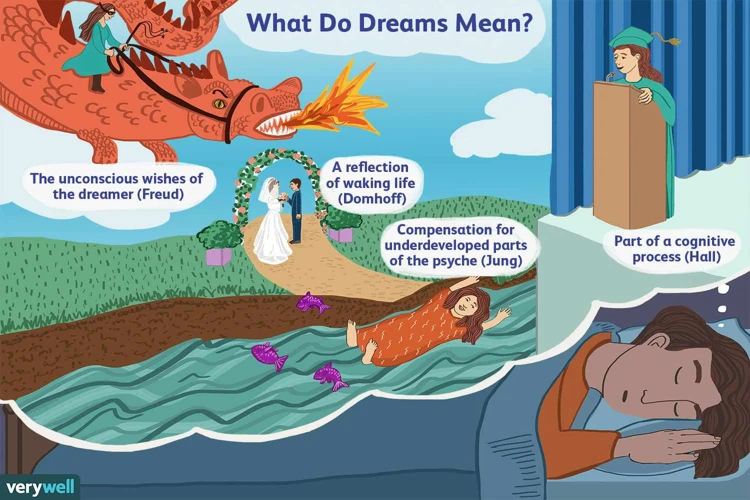Have you ever woken up from a dream with a vivid image etched into your mind? It’s no secret that dreams are a mysterious and fascinating phenomenon that has captivated humans for centuries. In this article, we will delve deep into the world of dreams, exploring their meanings and the intricate symbols they often present. Specifically, we will focus on understanding the underlying meaning of an image from a dream, step-by-step. By unraveling the symbolism and deciphering the messages hidden within our dreams, we can gain valuable insights into our subconscious minds. So, join us on this journey of self-discovery as we embark on an exploration of the enigmatic realm of dream interpretation.
Understanding Dreams

Dreams have long fascinated and perplexed us with their enigmatic nature. They are powerful experiences that occur during sleep, transporting us to vivid and often surreal worlds. Delving into the realm of dreams requires us to understand their definition and purpose. By unraveling the mysteries of dreams, we can gain a deeper understanding of ourselves and the messages our subconscious minds are trying to convey. So, let’s embark on this fascinating exploration of the realm of dreams and unlock their hidden meanings.
Definition of Dreams
Dreams, as defined by experts, are subjective experiences that occur during sleep. They often involve a combination of vivid imagery, emotions, and sensations that feel real to the dreamer. Dreams can be fleeting and quickly forgotten upon waking, or they can leave a lasting impact, lingering in our minds throughout the day. They can range from peaceful and mundane to surreal and fantastical, reflecting the vast landscape of our imagination and unconscious mind. The exact purpose and meaning of dreams are still open to interpretation, but they continue to intrigue and captivate us, offering profound insights into our inner selves.
The Purpose of Dreams
The purpose of dreams is a subject that has long puzzled experts and remains a topic of debate. While there are various theories, it is widely believed that dreams serve multiple purposes. One such purpose is to help us process and make sense of our daily experiences and emotions. Dreams also provide a space for our subconscious minds to work through unresolved conflicts and fears. They can serve as a form of therapy, offering a means for emotional release and problem-solving. Additionally, dreams may offer glimpses into our innermost desires, allowing us to explore our aspirations and aspirations freely. By understanding the purpose of dreams, we can begin to appreciate the significance they hold in our lives.
Analyzing Dream Images

When it comes to understanding dreams, analyzing dream images plays a crucial role. Dreams often communicate through symbolism, using powerful images and metaphors to convey their messages. By examining these dream images, we can unravel their underlying meanings. One way dreams utilize symbolism is by representing emotions or experiences through objects or scenarios. For instance, dreaming of flying may represent a sense of freedom or empowerment. Additionally, interpreting dream images involves considering personal associations and archetypal symbols. Keeping a dream journal can be immensely helpful in documenting and analyzing these dream images, allowing us to gain insights into the intricate world of our dreams.
How Dreams Use Symbolism
Dreams have a unique way of communicating through symbolism. Rather than presenting literal representations, dreams often use symbols to convey deeper meanings and emotions. The use of symbolism in dreams allows the subconscious mind to express complex ideas and concepts that may be difficult to articulate in everyday life. Symbols can take various forms, such as animals, objects, colors, or even certain scenarios. Each symbol holds its own significance and may vary in meaning for different individuals. To understand the symbolism in dreams, it is essential to analyze the context, personal associations, and cultural significance behind each symbol. By deciphering the symbolic language of dreams, we can uncover hidden messages and gain profound insights into our inner selves.
Interpreting Dream Images
Dream images are like fragments of a complex puzzle, waiting to be deciphered. When interpreting dream images, it’s crucial to recognize the use of symbolism by our subconscious minds. Symbols in dreams can hold deep meanings and represent hidden emotions, desires, or fears. To interpret dream images, start by examining the context in which they appear and the emotions they evoke. Connecting these elements can offer valuable insights into our subconscious thoughts and experiences. Additionally, keeping a dream journal can help identify recurring symbols or patterns, providing further clues for interpretation. By honing our ability to interpret dream images, we can unravel the messages and gain a deeper understanding of ourselves.
Image from a Dream: The Experiences and Scenarios

When we dream, our minds create a tapestry of images, experiences, and scenarios that can range from the mundane to the fantastical. Each dream is unique, offering a glimpse into a world that exists solely within our subconscious. An image from a dream can be a powerful focal point, holding symbolic significance that can provide valuable insights into our innermost thoughts and emotions. Describing the image from a dream involves capturing its essence and detailing the experiences and scenarios surrounding it. By painting a vivid picture of the dream image, we can begin to unravel its deeper meanings and uncover the hidden messages it holds.
Description of the Image
When exploring the underlying meaning of an image from a dream, the first step is to provide a detailed description of the image itself. Take a moment to vividly recall the image and its various elements. Is it a person, an object, or a scene? Note down any distinct features or characteristics that stood out to you. By capturing the visual details, colors, and shapes, you can paint a clear picture of the image. Additionally, consider the setting and any significant context surrounding the image. This detailed description forms the foundation for further analysis and interpretation.
Emotions and Feelings Associated with the Image
When analyzing an image from a dream, it’s essential to explore the emotions and feelings that are associated with it. These emotions provide valuable insights into the deeper meaning behind the image. Take a few moments to reflect on the image and identify the emotions it evokes. Is it a feeling of joy, fear, sadness, or confusion? Creating a list of these emotions or describing them in a table can help you to analyze and interpret the underlying message of the dream image more effectively. By acknowledging and understanding the emotions and feelings associated with the image, you can uncover the profound significance it holds in your subconscious mind.
Example:
Emotions and Feelings Associated with Dream Image:
- Fear
- Curiosity
- Anxiety
- Intrigue
Unearthing the Symbolic Meanings

In order to fully understand the underlying meaning of an image from a dream, it is essential to unearth the symbolic meanings that lie within. Dreams often utilize archetypal symbols that have universal significance, as well as personal symbols that are unique to each individual. Archetypal symbols, such as water representing the subconscious mind or a snake symbolizing transformation, provide deep insights into the human experience. On the other hand, personal symbols may be specific to an individual’s memories, experiences, or cultural background. By carefully analyzing these symbols and their associated associations, we can unravel the layers of meaning embedded within our dreams. Whether through creating a visual table or listing out the symbolic elements, the process of unearthing these meanings requires attentiveness and an open mind.
Archetypal Symbols in Dreams
Archetypal symbols in dreams are universal patterns that exist across cultures and have been passed down through generations. These symbols tap into the collective unconscious, a concept introduced by Swiss psychiatrist Carl Jung. Some common archetypal symbols include the hero, the wise old man or woman, the shadow, and the trickster. These symbols hold deep meaning and often represent primal human experiences and emotions. For example, the hero archetype may symbolize bravery, courage, and the journey of self-discovery, while the wise old man or woman archetype may represent wisdom, guidance, and intuition. Understanding these archetypal symbols can provide valuable insights into our dreams, helping us navigate our own personal journeys and uncover profound truths about ourselves.
Personal Symbols and Associations
When it comes to dream interpretation, a crucial aspect is understanding personal symbols and associations. Each individual has their unique set of symbols that hold personal meaning. These symbols can be derived from personal experiences, cultural influences, or even childhood memories. For instance, a dream about a butterfly may hold different meanings for different people. For some, it may symbolize transformation and growth, while for others, it may evoke feelings of freedom and beauty. To decipher the personal symbols in dreams, it is essential to reflect on the emotions, memories, and associations that arise when encountering specific images. By creating a personal dream dictionary, noting down these symbols and their personal significance, we can unlock deeper layers of meaning within our dreams.
Exploring the Underlying Meanings

Exploring the underlying meanings of the images from our dreams is an intriguing and thought-provoking endeavor. By analyzing the symbols and scenarios presented in our dreams, we can unveil deeper insights into our subconscious thoughts, emotions, and desires. Each dream image holds the potential for multiple interpretations, allowing us to tap into a vast reservoir of hidden meanings. By considering different perspectives and drawing connections to our personal experiences and associations, we can begin to unravel the intricate tapestry of our dreams. This process of exploration takes us on a captivating journey of self-discovery, allowing us to gain a greater understanding of ourselves and the hidden messages that lie within our dreams.
Possible Interpretations of the Image
When attempting to interpret the image from a dream, it’s important to approach it with an open mind and consider various possible meanings. Here are a few potential interpretations to consider:
1. The image may represent a deeply rooted fear or anxiety that needs to be addressed in our waking life.
2. It could symbolize a desire or longing that we may not be fully aware of or have suppressed.
3. The image might reflect a significant event or person from our past that still holds emotional weight.
4. Alternatively, it could be a reflection of our aspirations and goals, serving as a reminder of what we truly desire.
Remember, interpretation is highly personal, and it’s essential to explore the image in the context of one’s own emotions, experiences, and associations. Trusting our intuition and allowing ourselves to delve into the deeper layers of symbolism can lead to profound insights and self-discovery.
Understanding the Subconscious Messages
Understanding the subconscious messages hidden within our dreams is a key aspect of dream analysis. Our dreams often serve as a medium through which our subconscious mind communicates with us. These messages can reveal unresolved emotions, fears, desires, or even provide guidance on a particular situation. To grasp the true meaning of these messages, it’s essential to approach our dreams with an open mind and a willingness to explore deeper layers of our psyche. With the help of symbols, emotions, and recurring themes in our dreams, we can decode the messages our subconscious mind is trying to convey. This process requires patience, introspection, and a willingness to embrace our innermost thoughts and feelings. By understanding the subconscious messages in our dreams, we can gain valuable insights that can enhance our personal growth and well-being.
The Importance of Reflecting on Dream Images
Reflecting on dream images is of utmost importance if we wish to gain insight into our subconscious minds and harness the wisdom they offer. When we take the time to analyze and reflect on the imagery presented in our dreams, we open a doorway to self-discovery and personal growth. By interpreting the symbols, emotions, and themes within our dream images, we can gain a deeper understanding of our fears, desires, and unresolved issues. Integrating these insights into our daily lives allows us to make positive changes, resolve inner conflicts, and embark on a journey of self-improvement. Keeping a dream journal is a powerful tool that aids in this reflection process. By jotting down our dreams immediately upon waking, we capture the essence of the imagery and emotions experienced, enabling us to revisit and analyze them later. Through reflection, we unlock the transformative potential within our dreams, embarking on a path of personal exploration and self-awareness.
Integration of Dream Insights into Daily Life
Integrating dream insights into our daily lives is a powerful practice that allows us to bridge the gap between our subconscious and conscious selves. The messages and symbols we encounter in our dreams can provide profound guidance and understanding. To make the most of these insights, it is important to actively reflect on our dreams and consider how they apply to our waking life. One way to do this is by engaging in self-reflection and journaling. Keeping a dream journal helps us capture the details of our dreams and provides a space for deeper analysis. By examining our dreams and identifying recurring themes or symbols, we can begin to recognize patterns and make connections to our daily experiences. Another valuable practice is to consciously incorporate dream insights into our decision-making process and personal growth. By acting upon the wisdom gained from our dreams, we can lead a more fulfilling and authentic life. So, embrace the symbiotic relationship between dreams and reality, and allow your dream insights to illuminate your path forward.
Keeping a Dream Journal
Keeping a dream journal is an invaluable tool for unlocking the secrets of our dreams. This practice involves recording our dreams immediately upon waking, capturing as many details as possible. By jotting down the imagery, emotions, and symbols from our dreams, we create a repository of valuable insights. Maintaining a dream journal allows us to track recurring themes, patterns, and symbols, aiding in the interpretation of our dreams. It also helps us recall dreams more clearly over time and enhances our overall dream recall abilities. So, grab a notebook or use a digital journal and make it a habit to document your dreams regularly to tap into the wealth of wisdom they hold.
Conclusion
In conclusion, exploring the underlying meaning of an image from a dream can provide us with valuable insights into our subconscious minds. Dreams are rich in symbolism, using archetypal and personal symbols to convey messages and emotions. By analyzing and interpreting dream images, we can uncover the deeper meanings they hold and gain a deeper understanding of ourselves. It is essential to reflect on dream images, integrate the insights into our daily lives, and keep a dream journal to preserve and explore the symbolism further. So, let us continue to embrace the captivating world of dreams and unravel the mysteries that lie within.
Frequently Asked Questions
What are lucid dreams?
Lucid dreams are dreams in which the dreamer is aware that they are dreaming. This awareness allows the dreamer to consciously control their actions and experiences within the dream.
Can dreams predict the future?
While dreams can sometimes be eerily prophetic, there is no scientific evidence to suggest that dreams can predict specific future events. However, dreams may provide insights and symbolism that can be interpreted to gain a deeper understanding of our lives.
Why do we forget our dreams?
Forgetting dreams is a common occurrence due to a phenomenon known as “dream amnesia.” The brain tends to prioritize the storage of more important information, such as waking experiences, over dreams, causing them to fade from memory quickly.
What is the significance of recurring dreams?
Recurring dreams often indicate unresolved issues, emotions, or patterns in our lives that require our attention. They serve as wake-up calls from our subconscious, urging us to address these recurring themes in our waking lives.
Can dreams have multiple meanings?
Yes, dreams can have multiple meanings depending on the individual and the context of their life. The same dream image can symbolize different things for different people, influenced by their personal experiences, beliefs, and emotions.
Do all dreams have symbolic meaning?
Not all dreams have symbolic meanings. Some dreams may simply be a replay of daily events or a processing of thoughts and emotions. However, analyzing dream symbols can often uncover valuable insights into our subconscious minds.
Are nightmares always negative?
While nightmares are typically associated with negative emotions and frightening experiences, they can serve a purpose. Nightmares often reveal our deepest fears and can pave the way for personal growth and self-reflection.
Why do we dream in color?
The majority of dreams are experienced in color due to the brain’s ability to recall and create visual images. The vibrant and realistic colors in dreams contribute to the overall vividness of the dream experience.
Can interpreting dreams help with problem-solving?
Yes, interpreting dreams can be a helpful tool for problem-solving. Dreams have the ability to present alternative perspectives, creative solutions, and insights into our unconscious thoughts, which can aid in finding solutions to real-life challenges.
How can external factors influence our dreams?
External factors, such as daily stress, medications, or even what we eat before bed, can influence the content and emotional tone of our dreams. Being mindful of these factors and their potential impact can help in understanding our dreams more effectively.

